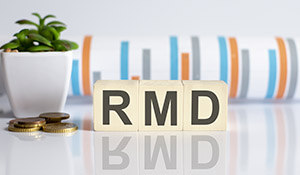Can You Lower Your RMD Taxes?
November 25th, 2020 | 3 min. read

Retirement comes with a great financial twist. During your working years, the federal government incentivizes you to save in retirement accounts with tax deferrals. But eventually you are forced by the government to spend down those same accounts in the form of required minimum distributions (RMDs).
RMDs are the amounts the government mandates you to withdraw annually from your traditional retirement accounts after turning 72 years of age. You may also be required to take RMDs from retirement accounts you inherit.
With the start of RMDs could come higher taxes, as they are generally treated as ordinary income for tax purposes. And if you don’t take your full RMD, you may owe substantial penalties.
So, can you lower your RMD taxes? While you may not be able to completely avoid the tax man, there are ways to limit the tax hit.
How RMDs are taxed
You generally must take an RMD from any retirement account in which you have made tax-deferred contributions or had tax-deferred earnings. These are employer-sponsored accounts (401(k), 403(b), etc.) and traditional IRAs.
When you reach age 72, you are required to withdraw at least a certain amount – your RMD – from each of those accounts every year and pay ordinary income taxes on these withdrawals.
If you have an inherited IRA, you may also be required to take RMDs, depending on your relationship to the original accountholder. Non-spouse beneficiaries who inherit an IRA from someone who passed away in 2020 or later must withdraw the entire account balance within 10 years. There are exceptions. Spousal and some eligible non-spouse beneficiaries may be able to take RMDs over their own life expectancies.
Delaying your first RMD
If you are worried about the tax impact of your first RMD, the good news is you can put it off.
You are supposed to take your first RMD in the year in which you turn 72 years of age. You can, however, delay your first one until April 1 of the year following the year in which you turn 72. All subsequent distributions must be withdrawn each year by December 31.
Just keep in mind that delaying your first RMD until April 1 will result in taking two distributions in a single year, which may affect your taxable income in a different way.
If you don't take your RMD by the deadline or if you take less than you're supposed to, you could be subject to a steep 50% penalty on the shortfall. For example, if your RMD is $50,000 and you only take $30,000, you'd be short $20,000 and could owe a penalty of $10,000.
Roth IRA conversion
One way to avoid RMDs is to convert all or some of your savings into a Roth IRA. Unlike traditional IRAs, Roth IRAs are not subject to RMDs.
Since contributions to a Roth account are taxed upfront, withdrawals are tax free. (That is once you are older than age 59 ½ and meet the five-year holding requirement, which specifies that five years must pass before you can withdraw your earnings in the account tax-free.)
However, that also means you are required to pay federal income taxes on the funds you convert. Therefore, you want to consider how much you can convert without moving into a higher tax bracket. The tax rate is based on the year in which you make the conversion.
Whether this makes sense for you depends on your tax situation now and expected tax situation in the future. If your income is lower this year than a typical year, for example, a conversion may make sense for you.
Since Roth IRA conversions can get tricky and could result in costly tax mistakes if done incorrectly, it’s best to speak with a financial adviser first.
Work longer
Another instance of when you can delay RMDs is in the event you keep working. Those who save in an employer-sponsored account, continue to work past age 72 and don’t own 5% or more of the company, can delay distributions from their current workplace account until they retire. RMDs, however, are still required from your IRAs and accounts with previous employers.
Qualified charitable distribution (QCD)
One way to give back and save on taxes is to donate your RMD to charity, if you don’t need the full amount. IRA owners who are age 70 ½ or older can directly transfer, tax-free, up to $100,000 per year to an eligible charity.
In addition to the tax savings, your contributions count toward your RMDs.
For the contribution to be tax-free, the funds must be sent directly from your IRA to the receiving charity. You can’t just withdraw the money and then write a check. Further, the recipient charity must be registered as an eligible 501(c)(3) organization.
To ensure that you are properly donating to the charity of your choice and that it fully counts toward your RMDs, consider working with your financial adviser or IRA custodian.
Most likely you will need at least some of your RMDs to help cover your retirement expenses. But for those who don’t need all the money, it makes sense to try to manage your tax burden and keep that money working for your financial goals.
Advance Capital Management is a fee-only RIA serving clients across the country. The Advance Capital Team includes financial advisers, investment managers, client service professionals and more -- all dedicated to helping people pursue their financial goals.
